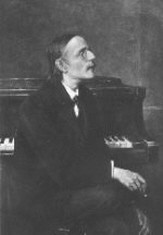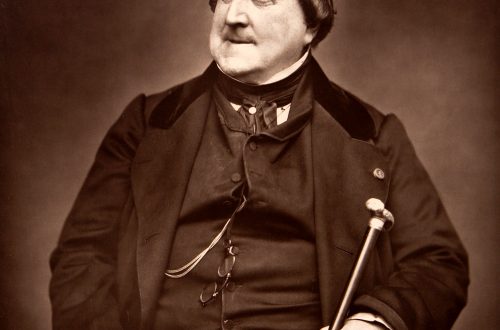Paul Dessau |
Paul Dessau
In the constellation of names of figures representing the literature and art of the GDR, one of the places of honor belongs to P. Dessau. His work, like the plays of B. Brecht and the novels of A. Segers, the poems of I. Becher and the songs of G. Eisler, the sculptures of F. Kremer and the graphics of V. Klemke, the opera direction of V. Felsenstein and the cinematographic productions of K. Wulff, enjoys well-deserved popularity not only on homeland, it won wide recognition and became a vivid example of the art of the 5th century. The vast musical heritage of Dessau includes the most characteristic genres of modern music: 2 operas, numerous cantata-oratorio compositions, XNUMX symphonies, orchestral pieces, music for drama performances, radio shows and films, vocal and choir miniatures. Dessau’s talent manifested itself in various areas of his creative activity – composing, conducting, teaching, performing, musical and social.
A communist composer, Dessau sensitively responded to the most important political events of his time. Anti-imperialist sentiments are expressed in the song “Soldier Killed in Spain” (1937), in the piano piece “Guernica” (1938), in the cycle “International ABC of War” (1945). The Epitaph for Rosa Luxemburg and Karl Liebknecht for choir and orchestra (30) is dedicated to the 1949th anniversary of the tragic death of prominent figures of the international communist movement. A generalized musical and journalistic document dedicated to the victims of apartheid was Lumumba’s Requiem (1963). Other memorial works by Dessau include the vocal-symphonic Epitaph to Lenin (1951), the orchestral composition In Memory of Bertolt Brecht (1959), and the piece for voice and piano Epitaph to Gorky (1943). Dessau willingly turned to the texts of modern progressive poets from different countries – to the work of E. Weinert, F. Wolf, I. Becher, J. Ivashkevich, P. Neruda. One of the central places is occupied by music inspired by the works of B. Brecht. The composer has works related to the Soviet theme: the opera “Lancelot” (based on the play by E. Schwartz “Dragon”, 1969), music for the film “Russian Miracle” (1962). Dessau’s path into the art of music was driven by a long family tradition.
His grandfather, according to the composer, was a famous cantor in his time, endowed with composing talent. The father, a tobacco factory worker, until the end of his days retained his love for singing and tried to embody his unfulfilled dream of becoming a professional musician in children. From early childhood, which took place in Hamburg, Paul heard the songs of F. Schubert, the melodies of R. Wagner. At the age of 6, he began to study the violin, and at 14 he performed at a solo evening with a large concert program. From 1910, Dessau studied at the Klindworth-Scharwenka Conservatory in Berlin for two years. In 1912, he got a job at the Hamburg City Theater as an orchestra concertmaster and assistant to the chief conductor, F. Weingartner. Having long dreamed of being a conductor, Dessau eagerly absorbed the artistic impressions from creative communication with Weingartner, enthusiastically perceived the performances of A. Nikisch, who regularly toured in Hamburg.
Dessau’s independent conducting activity was interrupted by the outbreak of the First World War and the subsequent conscription into the army. Like Brecht and Eisler, Dessau quickly recognized the senseless cruelty of the bloody massacre that claimed millions of human lives, felt the national-chauvinistic spirit of the German-Austrian military.
Further work as the head of the orchestra of opera houses took place with the active support of O. Klemperer (in Cologne) and B. Walter (in Berlin). However, the craving for composing music gradually more and more replaced the former desire for a career as a conductor. In the 20s. a number of works for various instrumental compositions appear, among them – Concertino for solo violin, accompanied by flute, clarinet and horn. In 1926 Dessau completed the First Symphony. It was successfully performed in Prague conducted by G. Steinberg (1927). After 2 years, Sonatina for viola and cembalo (or piano) appeared, in which one feels closeness to the traditions of neoclassicism and orientation to the style of P. Hindemith.
In June 1930, Dessau’s musical adaptation of The Railway Game was performed at the Berlin Music Week festival. The genre of the “edifying play”, as a special kind of school opera, designed for children’s perception and performance, was created by Brecht and picked up by many leading composers. At the same time, the premiere of Hindemith’s opera-game “We are building a city” took place. Both works are still popular today.
1933 became a special starting point in the creative biography of many artists. For many years they left their homeland, forced to emigrate from Nazi Germany, A. Schoenberg, G. Eisler, K. Weil, B. Walter, O. Klemperer, B. Brecht, F. Wolf. Dessau also turned out to be a political exile. The Parisian period of his work (1933-39) began. The anti-war theme becomes the main impetus. In the early 30s. Dessau, following Eisler, mastered the genre of mass political song. This is how the “Thälmann Column” appeared – “… a heroic parting word to the German anti-fascists, heading through Paris to Spain to participate in the battles against the Francoists.”
After the occupation of France, Dessau spends 9 years in the USA (1939-48). In New York, there is a significant meeting with Brecht, which Dessau had long thought about. As early as 1936 in Paris, the composer wrote “The Battle Song of the Black Straw Hats” based on Brecht’s text from his play “Saint Joan of the Abattoirs” – a parody reimagined version of the life of the Maid of Orleans. Having become acquainted with the song, Brecht immediately decided to include it in his author’s evening at the studio theater of the New School for Social Research in New York. On texts by Brecht, Dessau wrote ca. 50 compositions – musical-dramatic, cantata-oratorio, vocal and choral. The central place among them is occupied by the operas The Interrogation of Lucullus (1949) and Puntila (1959), created after the composer’s return to his homeland. Approaches to them was the music for Brecht’s plays – “99 Percent” (1938), later called “Fear and Poverty in the Third Empire”; “Mother Courage and her children” (1946); “The Good Man from Sezuan” (1947); “Exception and Rule” (1948); “Mr. Puntila and his servant Matti” (1949); “Caucasian chalk circle” (1954).
In the 60-70s. operas appeared – “Lancelot” (1969), “Einstein” (1973), “Leone and Lena” (1978), the children’s singspiel “Fair” (1963), the Second Symphony (1964), an orchestral triptych (“1955″, ” Sea of Storms”, “Lenin”, 1955-69), “Quattrodrama” for four cellos, two pianos and percussion (1965). The “Elder Composer of the GDR” continued to work intensively until the end of his days. Shortly before his death, F. Hennenberg wrote: “Dessau retained his lively temperament even in his ninth decade. Asserting his point of view, he can sometimes hit the table with his fist. At the same time, he will always listen to the arguments of the interlocutor, never exposing himself as omniscient and infallible. Dessau knows how to be persuasive without raising his voice. But often he speaks in the tone of an agitator. The same goes for his music.”
L. Rimsky





